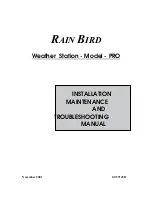
34
START UP THE COMMUNICATION:
• It is important to power up the base station before powering up the
outdoor sensor. Immediately after batteries are installed, the outdoor
sensor will start transmitting temperature data to the base station.
• It is strongly recommended to power up and test communication
between the outdoor sensor and the base station before permanently
mounting the sensor outside.
• During initial set up, place the outdoor sensor within one metre of the
base station, in the same room, with both the receiver and transmitter
far from any other electric product.
• After reception is established (remote readings will appear on the
base station’s display), position the outdoor sensor and the base sta-
tion within the maximum transmission range of up to 30 metres (100
feet).
Note:
• Avoid pressing any button on the base station before the remote
readings are displayed.
• Transmission or reception range may be affected by trees, metal
structures, electronic appliances, surrounding building materials and
how the base station and outdoor sensor are positioned.
PLACEMENT OF OUTDOOR SENSOR AND BASE STATION
• Place the outdoor sensor so that it faces the base station (receiver),
minimizing obstructions such as doors, walls and furniture.
• Though the outdoor sensors are weather resistant, they should be
placed away from direct sunlight, rain or snow. The optimal location
for the outdoor sensor is under the eaves on the north side of a build-
ing with free air circulation.
• The outdoor sensor can be placed on a fl at surface or mounted on a
wall vertically by using the included stand. To affi x the stand in place
use a screw rather than a nail.
• Ideally, place the outdoor sensor over soil, rather than asphalt, which
may affect the correct temperature measurement.
Summary of Contents for National Geographic 90-66000
Page 112: ...112...
Page 113: ...RU 113...
Page 114: ...114 2002 96 EG...
Page 115: ...RU 115 A D 1 2 3 Bresser GmbH CH Bresser GmbH DE 46414 Rhede Westf Germany...
Page 116: ...116 1 6 2 8 2 1 8 2 2 10 2 3 10 3 11 4 13 4 1 14 4 2 15 4 3 17 4 3 1 17 4 3 2 20 5 22 6 23 1...
Page 117: ...RU 117 DCF77 12 24 DCF77 12 24 7 433...
Page 118: ...118 2 2 1 A B H D G I E F J C...
Page 119: ...RU 119 A B C D E ALARM ALARM PRE AL ALARM ALARM F CHANNEL CHANNEL CHANNEL G MODE MODE...
Page 120: ...120 MODE F H I MEM MEM J 2 AAA 2 2...
Page 121: ...RU 121 2 3 A 2 B 3 A B W IRELESS THERMOMETER...
Page 122: ...122...
Page 123: ...RU 123 1 25 4 DCF77...
Page 124: ...124 12 00 6 8 4 1 70 4 2 C F...
Page 125: ...RU 125...
Page 126: ...126 CHANNEL Channel 1 2 3 CHANNEL MODE C F ALARM OFF ALARM ALARM...
Page 127: ...RU 127 MEM MIN MAX MEM 4 3 TIME 4 3 1 DCF77 1500...
Page 128: ...128 90 DCF77 3 10...
Page 129: ...RU 129 24 MODE EN DE FR IT SP DU SW MODE MODE MODE...
Page 130: ...130 MODE 30 MODE MODE 4 3 2 PRE AL 15 30 45 60 90...
Page 131: ...RU 131 1 ALARM OFF 2 MODE ALARM ALARM ALARM ALARM...
Page 132: ...132 ALARM 5...
















































